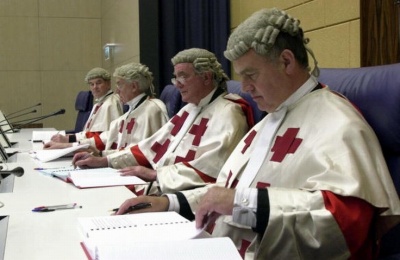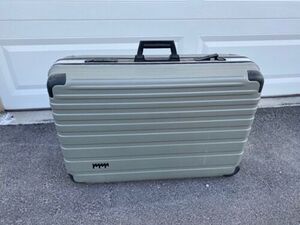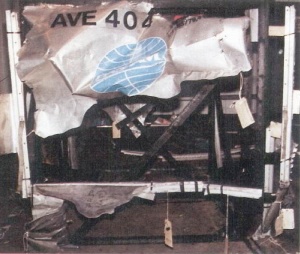Pan Am Flight 103/The Trial
 | |
| Date | 3 May 2000 - 31 January 2001 |
|---|---|
| Location | Camp Zeist, Netherlands |
| Website | http://web.archive.org/web/20020526115029/www.thelockerbietrial.com/ |
| Type | |
| Description | Judges at the Lockerbie Trial, sitting without a jury, convicted Abdelbaset al-Megrahi and sentenced him to life imprisonment |
Having been indicted in November 1991 in relation to the Lockerbie bombing, the two Libyans Lamin Khalifah Fhimah and Abdelbaset al-Megrahi were charged with conspiracy to murder, murder and a breach of the Aviation Security Act 1982, Section 2.[1]
The Lockerbie Trial at Camp Zeist in the Netherlands began on 3 May 2000 with a bench of three Scottish Judges - Lords Coulsfield, MacLean and Sutherland (Lord Abernethy as an alternate) - sitting without a jury.[2] Eight months later, the Crown said it intended dropping the charges of conspiracy and breach of aviation security and would be focusing on the charge of murder.
On 31 January 2001, the Judges' verdict was announced: Fhimah was found not guilty, Megrahi was found guilty of murdering 270 people and sentenced to life imprisonment.[3]
Contents
Personalities central to the prosecution's case
- Tony Gauci - The crown's star witness, a Maltese shopkeeper, reportedly paid a large amount by the CIA.[4]
- Thomas Thurman - FBI Laboratory 'scientist' was not called as a witness.
- Allen Feraday - Former head of the forensic laboratory at Royal Armaments Research and Development Establishment (RARDE) at Fort Halstead.
- Dr Thomas Hayes - Over the 1970s and early 1980s progressed to head the RARDE forensic laboratory. His testimony was central to the Lockerbie verdict. Yet he and two colleagues conspired to withhold evidence from the 1974 alleged IRA Maguire Seven trial which would have indicated innocence. The Maguires were freed on appeal after fifteen years in jail. This matter was exposed at the Lockerbie Trial, but the Judges trusted Hayes' word implicitly.
False claim by 'CIA stooge'
On 6 June 2000, one month after the trial started, the Daily Mirror reported that an Iranian terrorist Ahmad Behbahani who said he ordered the Lockerbie bombing was a CIA stooge. Behbahani told CBS television that the 1988 bombing was an Iranian plot using Libyan agents but sources close to the trial said Behbahani, who wanted asylum in America, was part of a CIA face-saving campaign. One Lockerbie expert told the Mirror:
- "For the last ten years the CIA has been saying it was Libya, Libya, Libya and nobody else was involved. But now the trial is actually taking place they have to change because the evidence is showing it is not just Libya."
Behbahani's allegations contradicted the prosecution case that the attack on Pan Am Flight 103 was planned and carried out by Libyan intelligence. But Edinburgh law professor Robert Black said the claims would not affect the Camp Zeist trial of Libyan suspects Abdelbaset al-Megrahi and Lamin Khalifah Fhimah:
- "These allegations need not have any effect on the trial because it is not about establishing the truth about Pan Am Flight 103. It has a simple limited objective and that is to prove beyond reasonable doubt the prosecution's indictment of the two suspects."[5]
Feraday's evidence
On 15 June 2000, Ian Ferguson summarised the day's proceedings on his website THELOCKERBIETRIAL.COM:
- Allen Feraday, one of the Crown's key forensic witnesses completed his evidence today. In his evidence in chief, he stated that the bomb, which destroyed Pan Am Flight 103 and killed 270 people, exploded 25 inches inside the fuselage.
- Feraday went to say that he had pinpointed the precise location of the blast after a detailed study of the damage suffered by all of the cases in the same luggage container as the bomb. He described that he found at least 13 items of clothing and parts of an umbrella that were inside the Samsonite case at the time of detonation. It was on the second layer of luggage, resting in the angled container overhang - roughly parallel to the fuselage - or leaning upright, propped against another luggage stack.
- During cross-examination by Richard Keen QC, Feraday was challenged on whether the bomb could have been in any other position than set out in his forensic conclusions, Feraday replied:
- "I can't think of any other position."
- He went on,
- "I am not saying there isn't any other position, I just can't find it myself."
- Later Feraday was asked about an earlier case in which he had testified, Regina v. Berry. Feraday's evidence was the single most important part of the prosecution's case against John Berry. The Court of Appeal rejected his "expert" evidence and Lord Chief Justice Taylor described Feraday's testimony at the trial as being "dogmatic".
- This questioning went not only to the witness's competency as an expert but also examined whether his professional opinion had changed from the time of the trial in the Berry case and the appeal. Feraday said he stood by his evidence at the Berry trial.
- Richard Keen QC asked him if he recalled a report he sent to John Orr, who at the time was heading the Police investigation at Lockerbie.
- The report is startlingly different from that reported to the court this week.
- Feraday stated in the first report that he was:
- "completely satisfied that the Lockerbie bomb had been contained inside a white Toshiba RT 8016 or 8026 radio-cassette player", and not, as he now testifies, inside a black Toshiba RT SF 16 model.
- Feraday was then challenged on his own handwritten notes and on whether they were taken contemporaneously or later. In some cases the official police log suggested that some pieces of evidence were not in Feraday’s possession when he claimed to have examined them and some were even logged as having been destroyed or returned to their owners prior to his examination having taken place.
- Feraday replied a "Higher National Certificate".
Ferguson's commentary
Undoubtedly Allen Feraday was an important witness for the Crown. His "dogmatic" approach in a number of cases is one of the hallmarks of his evidence. He is without doubt an expert at giving evidence, having done so often.
His evidence today under cross-examination though highlighted discrepancies in his note taking and raised again the issue of the accuracy of the police logs. Testimony, by police officers, early on in the trial showed that the logging of items was not as accurate as they claimed.
In his evidence under questioning from Richard Keen, Feraday dismisses the entire Court of Appeal in the John Berry case choosing instead to stick by his discredited evidence given at that trial.
His obvious scant regard for the Courts of Appeal coupled with his dogmatic approach to stick to his story must have deserted him when he appears to so willingly change his earlier report to the Police from being:
- "completely satisfied that the Lockerbie bomb had been contained inside a white Toshiba RT 8016 or 8026 radio-cassette player"
to as he now testifies:
- "inside a black Toshiba RT SF 16 model."
Perhaps Lord Chief Justice Taylor consulted the Concise Oxford dictionary before describing Feraday's evidence in the Berry case. It lists his description of Feraday's evidence like this:
- Dogmatic: adj. inclined to impose dogma; firmly asserting personal opinions as true.
- Origin: Dogma; a principle or set of principles laid down by an authority as incontrovertible.
Any one familiar with Allen Feraday's testimony in previous trials and in the Courts of appeal will know that incontrovertible is not always an apt description of his evidence.
More on previous Feraday trials soon.
Bernt Carlsson's suitcase

A few other issues arose in today's testimony by Allen Feraday, regarding the placement of the bomb suitcase:
- According to Feraday, he identified at least 13 items said to be from the Brown Samsonite suitcase, alleged to have contained the bomb. He pinpoints the location of the case down to the last centimetre, on the second layer of bags.
- Immediately below where Feraday claims the bomb went off, investigators identified a Grey Presikhaaf suitcase belonging to UN Commissioner for Namibia, Bernt Carlsson. In the early stages of the investigation, this suitcase was seen as the more likely bomb case. Police sources at the time said that this case was cleared of being the suspect case on November 23rd 1989.
- To date not one item from the contents of this Presikhaaf has been found. If there is a scientific reason why nothing has been found from this case, situated below the bomb case then it has not yet been explained in court. To a layperson it seems odd that the case adjacent to a bomb case should have no contents remaining, but from the bomb case itself we have an array of items.
- So what happened to the contents of Bernt Carlsson's Presikhaaf suitcase?[6]
Dropping the conspiracy charge
The unexplained dropping of the conspiracy charge continues to rankle with many Lockerbie campaigners. In July 2014, commenter "Dave" posted on Professor Black's blog:
- There would have been considerable pressure on the Judges to do their patriotic duty and find the two suspects guilty in defence of the system and of the Lord Advocate.
- And they did their duty by finding Abdelbaset al-Megrahi guilty, after saying he was innocent in their summing up!
- But to salve their conscience the Judges announced to the world that Zeist was a show trial by finding Lamin Khalifah Fhimah not guilty.
- Because how can you convict one without the other on a conspiracy charge?
- Thus, a deal must have been done, normally known as a plea bargain, but with the Judges, not the defendants![7]
However, Professor Black has no doubts about the Judges' integrity:
- This is utter nonsense, Dave. The Crown were as surprised as everyone else in the courtroom (and beyond) when the Judges returned a verdict of guilty against Megrahi. If you are going to continue contributing, please stop posting comments about what "must" have happened and start concentrating on what actually did.[8]
Evidence withheld or not available at the time of the trial
- Heathrow airport security guard Ray Manly discovered a break-in at the Terminal 3 Pan Am baggage facility early on Wednesday 21 December 1988:
- "I believe it would have been possible for an unauthorised person to obtain tags for a particular Pan Am flight then, having broken the ... lock, to have introduced a tagged bag into the baggage buildup area," Manly told the Metropolitan Police.
- The Heathrow break-in was not mentioned at the Camp Zeist trial that led to the 31 January 2001 conviction of Abdelbaset al-Megrahi, and only became public knowledge on 11 September 2001 (the day of 9/11) when the Scottish Mirror broke the story.[9]
- Former CIA agent, Robert Baer, CIA Middle Eastern specialist, worked on the early stages of the investigation. He has repeatedly claimed that, in 1989, there was "Grade A intelligence" held by America to prove that Iran requested and paid for the Lockerbie bombing. If Baer is correct, then the bomb timer fragment which pointed to Libya must have been planted.
- Lord Peter Fraser, Scotland's Chief Law Officer during the investigation and indictments, claimed in 1991 that witnesses would "prove the case beyond reasonable doubt." In 2005 he admitted to journalists that his chief witness Tony Gauci was highly unreliable. Then in 2008, when questioned by a Times journalist, Fraser indicated suspicions that key evidence might have been planted with the knowledge of the CIA.
- Shukri Ghanem, Libyan Prime Minister 2003 - 2006, has said, on at least two occasions in radio and television interviews, that Libya was not responsible and it paid the $2.7 billion compensation with great reluctance and only "to buy peace and move forward."
- The alleged bomb timer fragment: Was it planted to frame Libya for the crime?[10] The fragment's label had been altered by unknown persons. And its finding by Dr Thomas Hayes and examination by Allen Feraday proved highly suspicious. A series of scientific tests in 2009 have proved that its survival two centimetres from the centre of a high explosive fireball was impossible.[11]
Related Documents
| Title | Type | Publication date | Author(s) | Description |
|---|---|---|---|---|
| Document:Green Circuitboard Fragment - PT35 | Memo | 21 January 1990 | Alan Feraday | "The most important piece amongst PT35 is the fragment of green circuitboard – PT/35(b)." |
| Document:How Megrahi and Libya were framed for Lockerbie | article | 22 July 2010 | Alexander Cockburn | |
| Document:Justice for Megrahi awaits at the Supreme Court | Letter | 4 April 2021 | Patrick Haseldine | My recommendation, Mr Anwar, is that you appeal to the UK Supreme Court to quash the Scottish Court in the Netherlands' 2001 conviction of Abdelbaset al-Megrahi on the basis of fabricated timer fragment evidence led by the "non-expert witness" Allen Feraday |
| Document:Justice for Megrahi is gonna happen! | Letter | 14 April 2021 | Patrick Haseldine | Aamer Anwar said: "I have no doubt that the new democratic Libyan Government headed by Abdul Hamid al-Dabaiba will support this final appeal for justice on behalf of the Al-Megrahi family and help in our efforts to prove the innocence of Libya and its people." |
| Document:Lockerbie bombing: Megrahi's posthumous appeal rejected by Scottish judges | Article | 19 January 2021 | Steve James | No explanation or significance has been attached to a break in at Heathrow airport, where security was poor, the night before, adjacent to the luggage loading area for PA103. |
| Document:Lockerbie case: new accusations of manipulation of key forensic evidence | Statement | 28 August 2007 | Hans Köchler | Those responsible for the mid-air explosion of Pan Am Flight 103 will have to be identified and brought to justice. A continuation of the rather obvious cover-up which we have witnessed up until now is neither acceptable for the citizens of Scotland nor for the international public. |
| Document:The Lockerbie case and the corruption of justice | article | 9 August 2009 | Hans Köchler | |
| Document:The Political Scientists of Lockerbie - Allen Feraday | blog post | 26 October 2010 | Adam Larson | "Patrick Haseldine’s famously deleted Wikipedia page on Alan Feraday sums up nicely that he 'has appeared as an expert witness at criminal trials leading to convictions in at least four high-profile cases, three of which were subsequently overturned on appeal. The appeal in the fourth case is ongoing'.” |
| Document:The Political Scientists of Lockerbie - Thomas Hayes | blog post | 22 October 2010 | Adam Larson | Dr Thomas Hayes' testimony was central to the Lockerbie verdict. Yet he and two colleagues conspired to withhold evidence from the 1974 alleged IRA Maguire Seven trial which would have indicated innocence. The Maguires were freed on appeal after fifteen years in jail. This matter was exposed at the Lockerbie trial, but the Judges trusted Hayes' word implicitly. |
| Document:Was the MST-13 timer fragment planted in the wreckage of Pan Am 103 | Blog post | 15 September 2009 | Morag Kerr | You can set the MST-13 timer for any time you like from 1 minute to 999 hours before the bomb explodes. So you set it to go off only an hour after Pan Am Flight 103's scheduled take-off from Heathrow on an 8-hour flight. Really? |
| File:Koechler-lockerbie-appeal report.pdf | report | 26 March 2002 | Hans Köchler | A report on the appeal proceedings at the Scottish Court in the Netherlands |
References
- ↑ "Full wording of initial charges"
- ↑ "Terrorism on Trial: The Lockerbie Criminal Proceedings" Michael P. Scharf, ILSA Journal of International & Comparative Law, vol. 6, no. 2, Spring 2000, p. 355-362.
- ↑ "Lockerbie Judgment"
- ↑ "Revealed: CIA offered $2m to Lockerbie witness and brother"
- ↑ "Bomb claim link to CIA"
- ↑ "Feraday's Evidence-The Final Day"
- ↑ "A deal, normally known as a plea bargain, must have been done"
- ↑ "Watch it Dave or I'll ban you from commenting"
- ↑ "Lockerbie: Heathrow break-in revealed"
- ↑ Document:Was the MST-13 timer fragment planted in the wreckage of Pan Am 103?
- ↑ "Lockerbie's Twenty Nine year lie"
